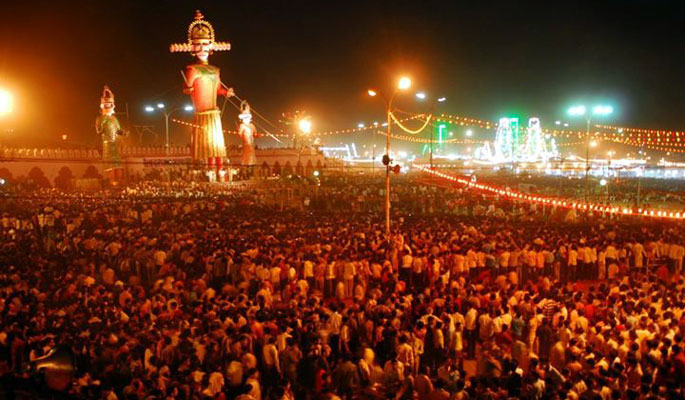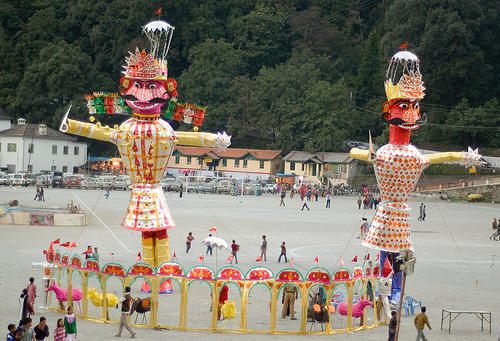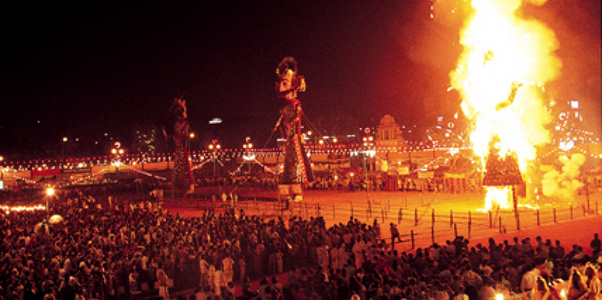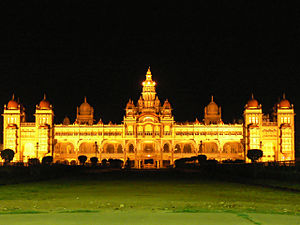Dussehra festival – Triumph of good over evil

Vijaya Dashami is also known as Dasahara, Dusshera, Dasara, Dussehra, or Dashain celebrates the triumph of good over evil and of the prevalence of truth. Vijaya Dasami is the tenth day of the bright half of the lunar month of Asvina which falls on Saturday, October 12th, 2024.
Dusshera, Durga Puja, and Navaratri are one and the same. Dussehra commences both the victory of the warrior Goddess Durga (consort of Shiva) over the buffalo demon, Mahishasura, and that of Rama (an incarnation of Lord Vishnu), over Ravana, the ten-headed king of Lanka, who had abducted Rama’s wife, Sita. Sri Rama worshipped Durga at the time of the fight with Ravana, to invoke Her aid in the war during the days preceding the Vijaya Dasami day. He fought and won through Her grace.
Durga represents the power of the Supreme god. The Divine mother Durga is represented as having ten different weapons in her ten hands and sitting on a lion. Mahishasura, a great demon, was severely oppressing the gods. Worship of the Goddess is the oldest tradition, significant in this case as it represents the female deity’s supremacy over the male Gods who are unable to destroy the demon. The gods invoked the aid of the Divine Mother Durga.
She assumed a form with ten hands bearing ten weapons and killed the Asura. Devi fought with Bhandasura and his forces for nine days and nine nights and completed the destruction of all Asuras on the evening of the tenth day, known as the Vijaya Dasami or the day of victory. All the ten days are sacred to Devi.
The Mother of Durga, wife of the king of Himalayas, longs to see her daughter Durga. Durga is permitted by Lord Siva to visit Her beloved mother only for three days in the year. The festival of Durga Puja is to celebrate this brief visit and it ends with the Vijaya Dasami day when the Goddess Durga leaves for Kailas. Durga worship also has social implications. As Goddess of war, she is a particular favorite of the Kshatriyas, the warrior caste, once constituting the ruling elite and aristocracy.
Celebrations Across India
Dusshera celebrations in India vary from region to region. In various parts of the country, all through Navaratras, Ramleelas use the Sahitya of the several versions of both the Desi and Margi streams of a tradition of the Ramayana to put on board a mind-boggling array of performances. The most well-known one started by the Raja of Benaras over a century ago, which is a magnificent form in itself of enacting the Ramayana of Tulsidas, composed in rhyming couplets.



During the Navaratri, the town of Ramnagar becomes one vast set of plays. Different scenes are enacted in different parts of the town, and the audience walks along with the actors of the play, involving themselves physically with the action of the narrative.
All over northern India, the culmination happens on Dussehra with three gigantic effigies of Ravana, Meghanath, and Kumbakarna being set aflame by the actor dressed as Rama, by shooting an arrow into Ravan’s navel. It is said that this particular time is the Vijay Vela when Rama had defeated Ravana and it is believed that anyone who wants to demolish or defeat his enemy must worship the Shami tree and set out of their homes in splendor in order to do so. This tree is said to be doubly auspicious as it was on the Shami that the Pandavas had hidden their weapons during the Agyatvaas, which was the last year of their Vanvas (exile) when they have to live in anonymity.
In Bengal, Durga Puja is a great festival. All who live away from home return home during the Puja days. Mothers meet their distant sons and daughters, wives their husbands. The Hindu woman of Bengal welcomes the Goddess with a mother’s love and sends away the image on the last day with every ceremony associated with a daughter’s departure for her husband’s home and with motherly tears in her eyes.
Mysore Dussehra
Down south, the city of Mysore is synonymous with its annual Dusshera procession. Chamundeshwari, the patron Goddess of the Mysore Royal family is worshipped with great fervor. After weeks of feverish preparations, a spectacular procession of floats, entertainers, and elephant wends its way through the streets of the city, complete with the erstwhile scion of the Mysore royal family astride an elephant. Perhaps a muscle-flexing exercise at some point in history, it is now a magnificent pageant reminiscent of the glory of the Maharajas of yore.

Kullu Dusshera
Not to be outdone is the Dussehra celebrations of Kullu, which nestles in the lap of the Himalayas. The festivities begin nearly 10 days in advance and as per tradition, Gods and Goddesses along with their followers of musicians and attendants descend from the neighboring peaks on the relatively flatter Kullu to make merry and attend the durbar of Lord Raghunath, who was brought from Ayodhya, nearly 300 years ago. While the celestial durbar is in place, people have a great time in the melas and animal fairs held on the occasion.
Kota Dussehra
Kota Dussehra is celebrated with zest and festivities as it also marks the beginning of the winter season after the long, unbearable, hot summer. Known as the industrial capital of Rajasthan, Kota has left its past to history books and pushed itself into the 21st century but the festival of Dussehra is still celebrated with great fervor and enthusiasm in myriad ways. Dussehra marks the victory of Ram over the demon king Ravana, and the rescue of his wife Sita. The demon king Ravana effigy as tall as 75 feet and above is set ablaze along with the effigies of Meghnad and Kumbhakarna. The Kota Dussehra Fair is held for 25 days.

Happy Vijayadashami 2024 – Greetings, wishes, quotes, and messages






